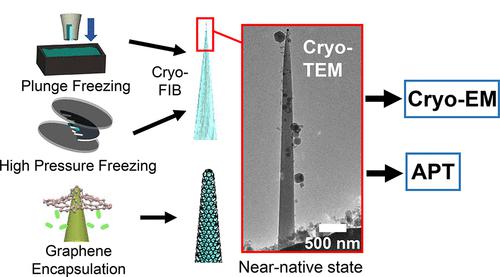当前位置:
X-MOL 学术
›
Nano Lett.
›
论文详情
Our official English website, www.x-mol.net, welcomes your
feedback! (Note: you will need to create a separate account there.)
Methods of Preparing Nanoscale Vitreous Ice Needles for High-Resolution Cryogenic Characterization
Nano Letters ( IF 9.6 ) Pub Date : 2022-08-04 , DOI: 10.1021/acs.nanolett.2c01495 Shuo Zhang 1 , Gediminas Gervinskas 2 , Shi Qiu 1 , Hari Venugopal 2 , Ross K W Marceau 3 , Alex de Marco 4, 5 , Jian Li 5, 6 , Jing Fu 1
Nano Letters ( IF 9.6 ) Pub Date : 2022-08-04 , DOI: 10.1021/acs.nanolett.2c01495 Shuo Zhang 1 , Gediminas Gervinskas 2 , Shi Qiu 1 , Hari Venugopal 2 , Ross K W Marceau 3 , Alex de Marco 4, 5 , Jian Li 5, 6 , Jing Fu 1
Affiliation

|
New high-resolution imaging methods for biological samples such as atom probe tomography (APT), facilitated by the invention of laser-pulsed atom probes and cryo-transfer procedures, have recently emerged. However, ensuring the vitreous state of the fabricated aqueous needle-shaped APT samples remains a challenge despite it being crucial for characterizing biomolecules such as proteins and cellular architectures in their near-native state. Our work investigated three potential approaches: (1) open microcapillary (OMC) method, (2) high-pressure freezing method (HPF), and (3) graphene encapsulation method. Diffraction patterns of the needle specimens acquired by cryo-TEM have demonstrated the vitreous state of the ice needles, although limited to the tip regions, has been achieved with the three proposed approaches. With the capability to prepare vitreous ice needles from hydrated samples of up to ∼200 μm thickness (HPF), combined use of the three approaches opens new avenues for future near-atomic imaging of biological cells in their near-native state.
中文翻译:

制备用于高分辨率低温表征的纳米级玻璃冰针的方法
最近出现了用于生物样品的新的高分辨率成像方法,例如原子探针断层扫描 (APT),这得益于激光脉冲原子探针和低温转移程序的发明。然而,确保制造的水性针状 APT 样品的玻璃态仍然是一个挑战,尽管它对于表征生物分子(如蛋白质和接近天然状态的细胞结构)至关重要。我们的工作研究了三种潜在的方法:(1)开放微毛细管(OMC)方法,(2)高压冷冻方法(HPF)和(3)石墨烯封装方法。通过低温 TEM 获得的针样本的衍射图案已经证明了冰针的玻璃态状态,尽管仅限于尖端区域,但已通过三种建议的方法实现。
更新日期:2022-08-04
中文翻译:

制备用于高分辨率低温表征的纳米级玻璃冰针的方法
最近出现了用于生物样品的新的高分辨率成像方法,例如原子探针断层扫描 (APT),这得益于激光脉冲原子探针和低温转移程序的发明。然而,确保制造的水性针状 APT 样品的玻璃态仍然是一个挑战,尽管它对于表征生物分子(如蛋白质和接近天然状态的细胞结构)至关重要。我们的工作研究了三种潜在的方法:(1)开放微毛细管(OMC)方法,(2)高压冷冻方法(HPF)和(3)石墨烯封装方法。通过低温 TEM 获得的针样本的衍射图案已经证明了冰针的玻璃态状态,尽管仅限于尖端区域,但已通过三种建议的方法实现。









































 京公网安备 11010802027423号
京公网安备 11010802027423号